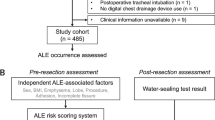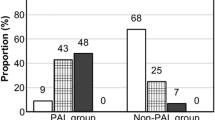Abstract
Purpose
Prolonged air leak (PAL) is a challenging complication in thoracic surgery. The aim of this study was to analyze the incidence, risk factors, and outcomes of PAL.
Methods
We retrospectively analyzed 319 patients treated in a single center submitted to lobectomy, bilobectomy, segmentectomy, and wedge resections from January 2012 until August 2015. PAL was defined as air leak lasting more than 7 days after surgery.
Results
The incidence of PAL was 14.7%. Bronchial obstruction (p < 0.05), low body mass index (BMI, p < 0.05), and hypoproteinemia (p < 0.001) were identified as independent preoperative risk factors of PAL. Intraoperative risk factors were lob- (p < 0.01) and bilobectomies (p < 0.05), pleural adhesions (p < 0.001), and length of stapler line (p < 0.001). Among the postoperative risk factors, we identified the use of active drainage (p < 0.01), the presence of subcutaneous emphysema (p < 0.001), massive air leak on the first postoperative day (POD 1, p < 0.001), and an incomplete re-expansion of the lung (p < 0.001). PAL was not associated with more complications in the postoperative period. One patient required reoperation due to a massive air leak. Twenty-six patients were discharged with a Heimlich valve with no complications and no need for re-admission.
Conclusions
Bronchial obstruction, low BMI, hypoproteinemia, lob- and bilobectomies, pleural adhesions, length of stapler line, use of active drainage, the presence of subcutaneous emphysema, massive air leak on POD 1, and incomplete re-expansion of the lung were identified as independent risk factors of PAL. It had no influence on outcomes.
Similar content being viewed by others
References
Cerfolio RJ, Bass CS, Pask AH, Katholi CR. Predictors and treatment of persistent air leaks. Ann Thorac Surg. 2002;73:1727–30.
Okereke I, Murthy SC, Alster JM, Blackstone EH, Rice TW. Characterization and importance of air leak after lobectomy. Ann Thorac Surg. 2005;79:1167–73.
Inoue H, Nishiyama N, Mizuguchi S, et al. Clinical value of exogenous factor XIII for prolonged air leak following pulmonary lobectomy: a case control study. BMC Surg. 2014;14:109.
Isowa N, Hasegawa S, Bando T, Wada H. Preoperative risk factors for prolonged air leak following lobectomy or segmentectomy for primary lung cancer. Eur J Cardiothorac Surg. 2002;21:951.
Okada S, Shimada J, Kato D, Tsunezuka H, Inoue M. Prolonged air leak following lobectomy can be predicted in lung cancer patients. Surgery Today. 2017;47:973–9.
Liberman M, Muzikansky A, Wright CD, et al. Incidence and risk factors of persistent air leak after major pulmonary resection and use of chemical pleurodesis. Ann Thorac Surg. 2010;89:891–7.
DeCamp MM, Blackstone EH, Naunheim KS, et al. Patient and surgical factors influencing air leak after lung volume reduction surgery: lessons learned from the National Emphysema Treatment Trial. Ann Thorac Surg. 2006;82:197–206.
Brunelli A, Varela G, Refai M, et al. A scoring system to predict the risk of prolonged air leak after lobectomy. Ann Thorac Surg. 2010;90:204–9.
Lee L, Hanley SC, Robineau C, , Sirois C, Mulder DS, Ferri LE. Estimating the risk of prolonged air leak after pulmonary resection using a simple scoring system. J Am Coll Surg. 2011;212:1027-1032.
Zhao K, Mei J, Xia C, et al. Prolonged air leak after video-assisted thoracic surgery lung cancer resection: risk factors and it’s effect on postoperative clinical recovery. J Thorac Dis. 2017;9:1219–25.
Pompili C, Falcoz PE, Salati M, Sznto Z, Brunelli A. A risk score to predict the incidence of prolonged air leak after video-assisted thoracoscopic lobectomy: An analysis from the European Society of Thoracic Surgeons database. J Thorac Cardiovasc Surg. 2017;153:957–65.
Wu X, Xu S, Ke L, et al. Establishment of a clinical prediction model of prolonged air leak after anatomic lung resection. Zhongguo Fei Ai Za Zhi. 2017;20:827–32.
Cerfolio RJ, Bass C, Katholi CR, et al. Prospective randomized trial compares suction versus water seal for air leaks. Ann Thorac Surg. 2001;71:1613–7.
Rivera C, Bernard A, Falcoz PE, et al. Characterization and prediction of prolonged air leak after pulmonary resection: a nationwide study setting up the index of prolonged air leak. Ann Thorac Surg. 2011;92:1062–8.
Lang P, Manickavasagar M, Burdett C, Treasure T, Fiorentino F. Suction on chest drains following lung resection: evidence and practice are not aligned. Eur J Cardiothorac Surg. 2016;49:611–6.
Leo F, Duranti L, Girelli L, et al. Does external pleural suction reduce prolonged air leak after lung resection? Results from the AirINTrial after 500 randomized cases. Ann Thorac Surg. 2013;96:1234–9.
Qui T, Shen Y, Wang MZ, et al. External suction versus water seal after selective pulmonary resection for lung neoplasm: a systematic review. PLoS One. 2013;8:e68087. https://doi.org/10.1371/journal.pone.0068087.
Gao S, Zhang Z, Aragon J. The Society of Translational Medicine: clinical practice guidelines for the postoperative management of chest tube for patients undergoing lobectomy. J Thorac Dis. 2017;9:3255–64.
Zhou J, Chen N, Hai Y, et al. External suction versus simple water-seal on chest drainage following pulmonary surgery: an updated meta-analysis. Interact CardioVasc Thorac Surg. 2019;28:29–36.
Author information
Authors and Affiliations
Corresponding author
Ethics declarations
Conflict of interest
The authors declare that they have no conflict of interest.
This article does not contain any studies with human participants or animals performed by any of the authors.
Informed consent was obtained from all individual participants included in the study.
Additional information
Publisher’s note
Springer Nature remains neutral with regard to jurisdictional claims in published maps and institutional affiliations.
Rights and permissions
About this article
Cite this article
Pischik, V.G., Maslak, O.S., Obornev, A.D. et al. Risk factors and outcomes of prolonged air leak after pulmonary resections. Indian J Thorac Cardiovasc Surg 35, 564–568 (2019). https://doi.org/10.1007/s12055-019-00827-w
Received:
Revised:
Accepted:
Published:
Issue Date:
DOI: https://doi.org/10.1007/s12055-019-00827-w




